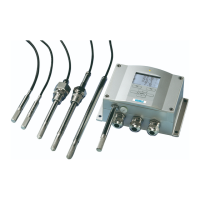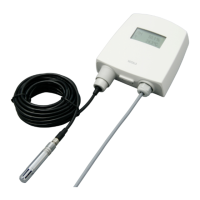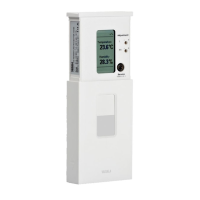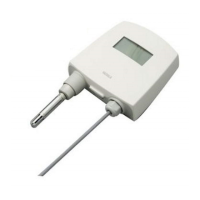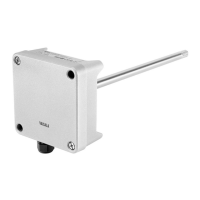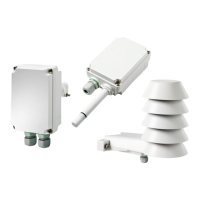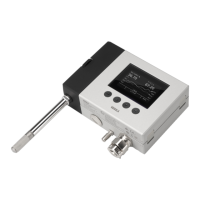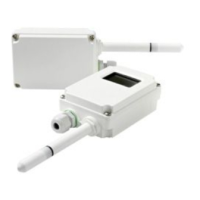
Do you have a question about the Vaisala HUMICAP HMT338 and is the answer not in the manual?
| Brand | Vaisala |
|---|---|
| Model | HUMICAP HMT338 |
| Category | Transmitter |
| Language | English |
Provides an overview of the manual's content, purpose, and structure.
Details manual revisions and the software versions they apply to.
Explains the meaning of warning, caution, and note symbols used in the manual.
Covers essential safety guidelines for handling and installing the HMT330 transmitter.
Provides guidelines to prevent damage from electrostatic discharge.
Instructions for proper recycling and disposal of the device and its components.
Lists EU directives and standards the HMT330 transmitter conforms to.
Details compliance with Det Norske Veritas' rules for classification.
FCC compliance information for transmitters with LAN or WLAN interfaces.
Lists patents protecting the HMT330 and registered trademarks.
Outlines software license terms and standard product warranty information.
Introduces the HMT330 transmitter's features, measurement capabilities, and output options.
Highlights key features, probes, optional modules, and connectivity.
Illustrates the physical components and connections of the HMT330 transmitter body.
Describes the various probe types available for different measurement applications.
Explains the purpose and operation of the HMT337 warmed probe for high humidity.
Details various methods for physically mounting the transmitter housing.
Instructions for mounting the transmitter using wall mounting kits.
Steps for installing the transmitter onto a standard DIN rail.
Guide for mounting the transmitter on poles or pipelines using specific kits.
Describes how to attach a rain shield for environmental protection.
Information on using a panel mounting frame for embedded installations.
Covers electrical wiring, cable bushings, and grounding for optimal performance.
Details on connecting signal wires and power supply to the transmitter terminals.
Specific guidance for safely connecting a 24 VAC power supply.
Essential considerations for correctly mounting humidity and temperature probes.
Best practices for mounting probes with cables horizontally or vertically.
Installation details for HMT333 (ducts) and HMT334 (high pressure).
Procedure for correctly tightening the probe's clasp nut.
Information on installing optional modules like power supply or communication interfaces.
Detailed steps for installing and connecting the power supply module.
Crucial safety warnings related to power supply and module installation.
Information on installing and wiring the third analog output module.
Details on installing, wiring, and configuring relay modules.
Information on installing and connecting the RS-422/485 interface module.
Guide for installing and configuring the LAN interface module.
Information on installing and configuring the WLAN interface module.
Steps for connecting the WLAN antenna to the transmitter.
Information on the optional data logger module and its installation.
Pinout details for the optional 8-pin connector used for modules and probes.
Initial steps and checks after powering up the transmitter for the first time.
Guide to using the optional display and keypad for device operation.
How to view measurement values on the basic numerical display.
Explains how to view data trends and min/max graphs.
Overview of accessing and navigating through the transmitter's menu system.
Configuring language, rounding, backlight, and contrast for the display.
Functions to lock the keypad and secure menu access with a PIN.
Setting and managing user-configurable alarms displayed on the screen.
Using the MI70 Link program for real-time monitoring and data transfer.
Connecting and communicating with the transmitter via User Port or Service Port.
Details on connecting to the user port and its operating modes.
Guide for connecting to and operating the transmitter via the service port.
Steps for setting up and managing network communication over LAN.
Configuring network settings like IP address, subnet mask, and gateway.
Setting up and managing wireless network parameters (SSID, security).
Setting and managing communication protocols for network interfaces.
Instructions for using terminal programs like PuTTY for serial/Telnet connections.
Comprehensive list and description of available serial commands.
How to retrieve measurement data via serial commands like R and SEND.
Customizing the format of serial output messages using commands.
Adjusting general parameters like quantities, units, and filtering.
Adjusting pressure compensation for accurate humidity readings.
Setting and configuring the device's date and time parameters.
Applying averaging filters to smooth measurement data.
Displaying detailed information about the transmitter's status and configuration.
Controlling the display backlight mode (on, off, auto).
Procedures to reset the transmitter via serial commands or keypad.
Functions to lock the menu or disable the keypad using serial commands.
Configuring serial communication parameters for the user port.
Information on the data recording function and selecting quantities to record.
Configuring analog output behavior, quantities, and scaling.
Performing tests to verify analog output functionality.
Configuring how analog outputs indicate device errors.
Detailed guide on configuring relay outputs, setpoints, and status indication.
Information on sensor functions like chemical purge and heating.
Steps for starting and configuring manual, automatic, and start-up chemical purges.
Information on the optional sensor heating function for high humidity.
Introduction to MODBUS variants and connections supported by HMT330.
Steps required to configure and start using MODBUS communication.
Guide to enabling MODBUS RTU over serial interfaces (RS-232/RS-485).
Steps to enable MODBUS TCP over Ethernet or WLAN interfaces.
How to view and clear MODBUS diagnostic counters for troubleshooting.
Procedures to disable MODBUS and switch to another operating mode.
Routine tasks for maintaining the transmitter's performance and longevity.
Detailed procedure for replacing the humidity or temperature sensor.
Describes how the transmitter indicates and reports errors.
Contact information for technical assistance and product return procedures.
Steps to enter and exit the calibration/adjustment mode on the motherboard.
Procedures for calibrating relative humidity using references via buttons or display.
Steps for recalibrating relative humidity after replacing the sensor.
Procedures for calibrating temperature using references via display or serial line.
Calibrating the analog output signals to known values using display or serial line.
Entering calibration date and text into the transmitter's memory.
Detailed performance parameters including measurement range and accuracy.
Temperature operating ranges and pressure limits for various HMT330 models.
Technical details including accuracy and range for the optional temperature probe.
Formulas and accuracy specifications for calculated variables like dewpoint.
Environmental conditions for transmitter operation and storage.
Electrical specifications for transmitter inputs, outputs, and communication interfaces.
Physical dimensions, materials, and mounting accessory details.
Detailed technical specifications for optional modules like power supply and relays.
Technical specifications for the optional data logger module.
List of optional modules and accessories with their order codes.
Physical dimensions for HMT331, HMT333, HMT334, HMT335, HMT337, HMT338.
Details on kits for installing HMT333/337/335 probes in ducts.
Kits for secure probe installation in pressure-tight applications.
Demonstrates vapor-tight installations using cable glands for RH probes.
Examples for vapor-tight T-probe installations.
Illustrates probe installation within a climate chamber environment.
Shows a method for installing probes through a roof structure.
Kit for connecting HMT338 probe to pressurized processes via ball valve.
Kit for outdoor installation of HMT337 for meteorological measurements.
Formula for calculating dewpoint temperature from RH and temperature.
Formula for calculating mixing ratio using pressure and water vapor pressure.
Formula for calculating absolute humidity from water vapor pressure and temperature.
Formula for calculating enthalpy based on temperature and mixing ratio.
Lists supported MODBUS function codes for transmitter communication.
Describes the memory map of MODBUS registers for data and configuration.
Explains numeric value representation (float, integer) in MODBUS.
MODBUS registers for accessing real-time measurement data (read-only).
MODBUS registers for device status and error information.
MODBUS registers used for configuring transmitter settings.
Summary of transmitter status provided via exception outputs.
Diagnostic functions for troubleshooting MODBUS communication.
MODBUS registers for retrieving device identification information.
MODBUS exception codes and their corresponding reasons.


